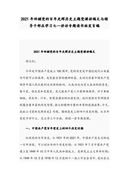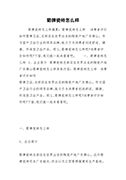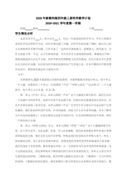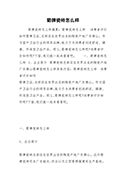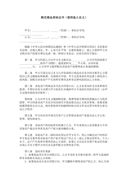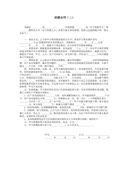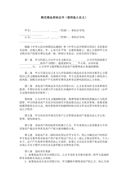《牛津小学英语》3A Unit6 Review and check(精选14篇)三年级英语教案
《牛津小学英语》3A Unit6 Review and check(精选14篇)
《牛津小学英语》3A Unit6 Review and check 篇1
第一课时
教材简析:
本单元是4a的期中复习单元,侧重归纳了第一至第四单元所涉及的语言项目。通过不同形式的复习,帮助学生归纳整理所学的词汇,日常交际用语和句型等,教师应根据学生的年龄特征及班级的具体情况,采用多种有效的教学手段活跃课堂气氛,激发学生的学习兴趣,帮助学生复习巩固本学期所学的词汇句型和日常交际用语。通过复习,让学生扎扎实实地掌握所学的知识,使每位学生在原有的基础上都有所提高。
教学内容:
复习动物类单词以及交际用语“what’s this/that in english ?it’s a ……”; “do you like this …? ”及其回答;
教学目标:
1. 学生能熟练掌握动物类单词。
2. 学生尽可能地把所学过的日常交际用语用到实践中。
教学理念:
1. 向全体学生,注重素质教育。
在教学中,要关注每个学生的情感,激发他们学习英语的兴趣,帮助他们建立学习的成就感和自信心 。
2. 采用活动途径,倡导体验参与。
采用任务型的教学模式,让学生在教师的指导下,通过感知、体验、实践、参与和合作等方式,实现任务的目标,感受成功。
教具准备:多媒体、图片、相关实物。
教学过程:
step1 warm up
1. greeting。(课件出示“动物王国”的画面,教室即“动物王国”,学生戴头饰扮演小动物。)
唱歌问候《how are you ?》
1. free talk:
t: today we have a new friend .listen !she is coming .
(课件:mickey mouse is coming .)
t: class , do you have any questions to ask mickey mouse ?
(生自由问问题。)
step2. 复习动物单词
1、t (扮演mickey mouse) :hello !what’s your name ?
s1: i’m a panda .
t : oh! panda ? good afternoon, panda ! can you find out your name and put it on the blackboard ?
s1: (find) panda . (生带领大家读单词,做动作)
用同样的方法将其他7个动物单词贴到黑板上。
read all the words .
2、play a game : “找蜜蜂”
t: now mickey mouse wants to play a game with us .
listen carefully .
(课件出示规则)
3、t: well done , boys and girls! now mickey mouse wants to take us to disneyland .迪斯尼乐园。do you want to go ?
ss : ok. let’s go .
step3. 复习句型“what’s this in english ?it’s a ……” “do you like this …? ”及其回答。
(课件出示迪斯尼乐园画面)
1、t: this is disneyland. is it beautiful ?
ss: yes, it is .
t:what’s this / that ? (利用句型“what’s this in english ?it’s a ……” “do you like this …? ”进行会话。)
t : now i’d like one student to be the mickey mouse .
(生扮演 mickey mouse ,与其他学生进行会话 )
t: ok, now let’s visit freedom .
ss work in pairs .( 自由参观。)
2、t : ( mickey mouse )ok.boys and girls ?
ss :yes ?
t: look ,here are three rooms .
intelligence room“智慧小屋”, music room“音乐ktv”
cartoon castle“动画城堡”
now let’s go into intelligence room first.
a、“智慧小屋”
(课件:在屏幕上你将会看到三个带着字母的气球,选择其中的一个填入空格内,使它成为一个完整的单词。)
t: ok, so much for this .let’s have a rest .let’s go to the music room .
b、“音乐ktv”
(课件:播放音乐,唱歌 “big / little…, big/little …,do you like big/little …? yes , i do / no, i don’t. . yes , i do / no , i don’t . .i (don’t) like big/little ….)
生自由练唱,上台表演。
t : now let’s go to the cartoon castle .
c、“动画城堡”
(课件 :播放动画 )
生看,跟读,配音。
step 4: 综合运用
t: good job ! you are so clever .are you happy ?
ss: yes .
t: now mickey mouse has something important to tell you .
listen carefully !
(课件:大家都知道我们动物王国有许多的外交小组,他们都很厉害。今天啊,应狮子大王的要求要在我们迪斯尼乐园进行“外交能力大比拼”,你们可以采用我们所给的这些句子自编字演一个对话,我们将选出“优秀外交组合”,现在就请大家准备一下吧。
参考句子:
what’s this / that in english ? it’s a ….
do you like …? yes, i do ./ no, i don’t .
i like …
this … is for you .
step 5 : goodbye !
《牛津小学英语》3A Unit6 Review and check 篇2
一、教材简解
本单元是前五个单元的复习单元,着重归纳了这五个单元的主要语言项目.教师尽可能地通过多种形式的复习,帮助学生巩固已学的单词及日常交际用语.教师可根据学生的年龄特点及学习的实际状况,采用多种活动形式,调动学生的学习积极性.
这五个单元的日常交际用语主要是围绕打招呼,问候,介绍以及请求和命令这几个功能项目展开,教师在复习过程中一定要注意语言与情景结合.
这一课时主要是围绕人物,颜色,动物,水果单词展开,在复习过程中,教师要根据学生的实际情况,处理好重点复习巩固内容.
二、目标预设
1.通过复习,学生掌握所学人物,颜色,动物,水果单词,并能熟练区分运用.
2.对于读音容易混淆的单词,重复其读音,使学生能正确的诵读,从而辨别单词.
3.培养学生听辨词组的能力.
4.通过复习,学生能熟练地把所学交际用语应用到日常生活中去,能在情境中恰当、得体地运用以上交际用语,与人打招呼、进行问候和介绍。
三、教学重、难点:
1.对于读音容易混淆的单词,重复其读音,使学生能正确的诵读,从而辨别单词.
2.培养学生听辨词组的能力.
3.通过复习,学生能熟练地把所学交际用语应用到日常生活中去,能在情境中恰当、得体地运用以上交际用语,与人打招呼、进行问候和介绍。
四、设计理念:
1.面向全体学生,突出学生主体。教学要面向全体学生,关注每个学生,激发他们学习英语的兴趣,鼓励学生大胆使用英语,通过体验、实践、讨论、合作、探究等方式,发展听、说、读的综合语言技能,做到学与用的结合。
2.采用多种教学方式,使单词和句式的操练富有意义,并激发学生的学习兴趣。
3.采用活动途径,倡导任务型的教学途径,培养学生综合语言运用能力。
4.能使已会的学生学到一些学习英语的方法,使学得不牢固的学生进行巩固.
五、设计思路:
本节课的教学内容是复习人物,颜色,动物,水果类单词,在此过程中,对已学的打招呼、介绍进行复习巩固,并通过歌曲、儿歌等方式吸引学生的兴趣,使他们在复习的同时感受收获的喜悦.我没有按照单元的顺序,而是把所学人物,颜色,动物,水果类单词进行了综合,从人物引到颜色,从颜色引到水果,从水果到动物,衔接自然,在复习的同时,教给了学生新知识.另外,我没有做书上的练习,而是请学生回家完成,这是因为我复习之前了解了学生情况,第六单元题目比较简单,有部分学生已经完成.
六、 教具准备:
课件 实物 图片 录音机 磁带 等
七、教学过程:
step 1. greetings
1. t: good morning , boys and girls.
s: good morning.
t: how are you?
s: fine. thank you. and you?
t: i’m fine, too. thank you.
2.sing a song 《how are you? 》
step 2.revision
1.(打开课件)出示人物,学生开火车朗读。
1)t:read their names.
s:liu tao ,wang bing ……
2) sing a song 《hi, nancy!》
3)(课件显示nancy’s family)t:look,this is nancy’s family.
the man is nancy’s
s: father .
t: we can say :
s: mr black .
read : father mr black
the same way : mother mrs black
brother david black
sister nancy black
4) act 扮演david或nancy介绍自己和自己的家人 :
good morning , .
i’m .
this is my …
nice to meet you . nice to meet you ,too.
5) sing a song 《hello! 》
6) (课件显示helen’s family)介绍helen’s family .
mr brown mrs brown
2.教师去掉mr brown ,mr black , mr green前的mr,并把b和g大写换成小写.
t:what’s this ?
s: black brown green
t: what do they mean ?
s: 黑色 棕色 绿色
t:they’re colours . anything else ?
s: red white …
read colours .
3. 1)t: listen to me :an orange orange
what does it mean ?
s: 一个橙色的桔子
讲解两个orange 的意思.
2)t: an orange 一个桔子,还有哪些水果?
s: an apple , a banana …
3) t: look and say : 一个红苹果 一根黄香蕉 一个橙色的菠萝
一个黄梨子 一个绿西瓜 一个黄芒果
4) say a rhyme 《they are all very good 》
4.1)t: this is a monkey .we can say :
s: nice to meet you ,mr monkey.
t: mr monkey says : i’d like some .
s: peaches
the same way : elephant --- bananas
2)复习动物类单词.
3)say a chant .
4)说一说短语:eg : a brown elephant …
5.用this is …介绍水果和动物.
step 3.drill
(投影仪显示)学生在练习纸上完成.
1. 听和选择:
this is mike’s family .the man is mike’s father , mr brown .he likes bananas. the woman is mike’s mother , mrs brown . she likes apples and watermelons . this girl is mike’s sister, helen . she likes oranges and peaches . mike likes pineapples . they are a happy family .
mr brown ( ) mrs brown ( )
helen ( ) mike ( )
a. apples b. oranges c. bananas d. pears
e. peaches f.mangoes g. watermelons h. pineapples
2.选出与其他三个不同类的一项
a b c d
( )1. a peach a banana hello a pear
( )2. a monkey a sofa a bed a table
( )3. a rubber a ruler a pen miss liu
( )4. miss li brown red blue
( )5. blue an orange an apple a mango
( )6. a panda a zebra a tiger white
3.从ⅱ栏中找出ⅰ栏的答句。
ⅰ ⅱ
( )1.what colour is it? a.all right.
( )2.nice to meet you. b.not bad,thank you.
( )3.go to school. c.see you.
( )4.good night. d.i’m yang ling.
( )5.how are you? e.good afternoon.
( )6.see you. f.no.
( )7.what’s your name? g.hello,liu tao.
( )8.hello,david. h.nice to meet you ,too.
( )9.an elephant? i.good night.
( )10.good afternoon. j.red.
4. 选择适合的汉语意思。
( )1、this is my mother . a.一只黑白相间的斑马
( )2、not bad , thank you . b. 早上好!
( )3、a black and white zebra c. 这是我的妈妈。
( )4、good morning . d.不错,谢谢你
( )5、nice to meet you , too. e.见到你也很高兴。
集体校对并且订正错误。
step 4.summary
师生总结所学内容,找出易错的地方进行巩固.
step 5.homework
1. 复习unit 1 - unit 3 .
2. 向家人用this is….句型介绍书中人物、水果和动物。
3. 完成中的unit 6 a,b 两个部分.
《牛津小学英语》3A Unit6 Review and check 篇3
一 教学目标
1 能听懂、会说、会读和会拼写单词a car, a bike, a bus 和 a kite。
2 能听懂、会说、会读和会写句型 what’s this/that in english? it’s a… do you like…? yes, i do. /no, i don’t.
3 能听懂、会说和会读日常交际用语 i loke puzzles. me, too. i love dolls. thank you very much. look at my kite. it’s nice. let’s…
4 初步了解名词的单复数。
5 了解辅音字母j 和 k 在单词中的发音。
6 能诵读歌谣 fly, fly my kite.
二 教学重难点
1能听懂、会说、会读和会拼写单词a car, a bike, a bus 和 a kite。
2能听懂、会说、会读和会写句型 what’s this/that in english? it’s a… do you like…? yes, i do. /no, i don’t.
三 课时安排:5课时
第一课时
教学内容:《牛津小学英语》4a unit 4
一 教学目标
1能正确听说读写词语in english, do, you, like, don’t, love, a puzzle, a kite, a doll.
2能正确运用日常交际用语 what’s this/that in english? it’s a puppet. do you like puppets? 及其回答 yes, i do./ no, i don’t.
3初步认识名词的单复数的基本形式。
二 教学重难点
1能正确听说读写词语in english, do, you, like, don’t, love, a puzzle, a kite, a doll.
2能正确运用日常交际用语 what’s this/that in english? it’s a puppet. do you like puppets? 及其回答 yes, i do./ no, i don’t.
3正确朗读单词 puppet, puzzle.
4比较流畅地朗读本课对话,并能在掌握本课对话内容的基础上用比较正确的读音、语调、表情和动作表演对话。
三 教学准备
1磁带和录音机。
2准备 puppet puzzle kite 和 doll等玩具和图片。
3新单词卡片 a kite, a doll, a puppet, a puzzle, love.
4请学生准备一些文具用品、玩具,要求色彩鲜明。
四 教学过程
a . free talk :
1. good morning/afternoon. / how are you?
2. t: hello.
s: hello, miss fan.
t: what’s that on your desk?
s: it’s a dog.
t: can i have a look?
s: sure.
t: oh, i love your dog.
…
b . presentation and practice
1.介绍生词
1)拿出玩偶说it’s a puppet,跟读。
2)show these toys to the ss and stick them on the bb.
2.介绍句型
1)t point to her toy and say, this is a … let ss introduce their toys with these sentences’ this is a …’ ‘that is a…’
2)t: what’s this /that in english?
s: it’s a ..
3)ss pratice the sentence with their toys. s----ss
4)t write down the sentences.
3.介绍名词单复数,生词like love和句型do you like/ love…?及其回答
1)t point to the toy and say, a puzzle---puzzles---i like puzzles.
2) ask the puppet: do you like puzzles?模拟回答 yes, i do./ no, i don’t.
3) the puppet ask t: do you like …? tell ss the differences between like and love.
4) ss practice.
c. read andsay
1.look at the pictures carefully and listen to the tape. guess are these sentences right?
yang ling is in nancy’s home.
yang ling and nancy like puppets.
they like kites.
yang ling and nancy like puzzles.
they don’t love dolls.
2.学生听录音,模仿。
3.自读课文。
4.分角色读。
5.师生分角色读。
6.同桌练习,表演。
7.上台表演。
d. consolidation
game t:what’s this…?
s:it’s a … (guess)
t:do you like this…?
s:yes, i do. i love…
t:here is a … for you.
s:thank you.
e.assign homework
1. 听录音,朗读,表演。
2. 自编对话。
第二课时
教学内容:《牛津小学英语》4a unit 4
一 教学目标
1.能正确听说读写单词a car a bus a bike a kite.
2. 能正确听说读单词 a balloon.
3. 能正确听说读写句子 what’s this/that in english?及其回答it’s a …
4. 能朗读歌谣fly, fly my kite
二 教学重难点
1. 能正确听说读写单词a car a bus a bike a kite.
2.能正确听说读单词 a balloon.
3. 能正确听说读写句子 what’s this/that in english?及其回答it’s a …
三 教学准备
1.准备八张图片及相应的单词卡片,录音机,磁带。
2.让学生准备自己的玩具。
3.板书准备。
四 教学过程
a.free talk
t: look,boys and girls. what’s this in english? (木偶)
s: it’s a puppet.
t: do you like puppets?
s:yes, i do. no, i don’t.
教师继续出示其他图片,替换示范。学生练习。
b. bevision
1. review read and say, act it.
2. 复习单词a puppet a puzzle a doll, 学生贴图片。
c. look read and learn
1. (气球) t: look at this picture. what’s this in english? oh, it’s a balloon. it’s red. it’s a nice balloon. do you like balloons?
ss: yes.
t: now read the word ‘balloon’ after me. can you put it on the bb?
2. play a game: what’s missing?
3. t:look at the picture. what’s this in english?
ss: it’s a car.
t: now let’s read andc spell the word ‘car’ (twice)
t:who can put it on the bb?
同法教其他单词。
4. play a game what’s missing?
这次要求拼写单词。
d. work in pairs
1.t: look here. what’s this in english?
ss: it’s a pen.
t: what’s that in english?
ss: it’s a book.
学生朗读,书写,抄写。
2. work in pairs.
e. say a rhyme
1. 听录音,欣赏
2. 介绍大义,朗读。
f. assign home work
1. 抄写四会单词和句子。
2. 朗读并默写四会单词和句子。
第三课时
教学内容:《牛津小学英语》4a unit 4
一 教学目标
1. 通过复习,掌握本单元的单词和句型what’s this/that in english?及其回答。
2. 进一步掌握句型do you like…? 及其回答。
二 教学重难点
1. 能四会掌握do you like… 及其回答。
三 教学准备
1.磁带 录音机 幻灯 玩具 图片
2.统计表
四 教学过程
a. free talk
1. say a rhyme
2. free talk
b. revision
t: now let’s review some words and sentences.
what’s this in english?
ss: it’s pen.
t: do youlike pens?
ss: yes, i do.
t: me, too.
同样的方法复习所有单词。
c. work in pairs
1. 出示表格ask and answer
name
kites
图
puppets
图
puzzles
图
dolls
图
s1
s2
示范,练习
2. practice in groups
3. report
1) how many ss like…?
2) who are they?
d. look and read
1.观察图片,了解大意
2.听录音,读故事
e. assign homework
1. 默写本单元的单词。
2. 用do you like…? 了解别人对物品的喜欢与否。
第四课时
教学内容:《牛津小学英语》4a unit 4
一 教学目标
1. 通过复习,掌握本单元所学的单词和句型。
2.能比较熟练地在情景中运用句型和交际用语。
3.能初步了解辅音字母j k在单词重的发音。
4.能有节奏地朗读歌谣。
二 教学重难点
1.能综合运用本单元的单词和举行。
2.能正确拼写玩具类的单词。
三 教学准备
1.磁带 录音机 实物投影仪 玩具 六种颜色牌子 水彩笔
2.学生带好玩具河水彩笔
四 教学过程
a. say a rhyme.
b. free talk
t: look! what’s this in english?
s: it’s a car.
t: do you like cars?
s: yes, i do. …
t: here’s a car for you.
学生用自己的玩具操练。
c. read and act
1. 出示风筝的头影片
t: what’s this in english?
ss: it’s a kite.
t: … come here ,please.
s1: all right.
t: look at my kite. do you like it?
s1: it’s nice. i like it.
t; let’s color it.
t: do you like red? …
2. 听录音两遍
3. ask and answer: whose kuite is it? do you like it?
4. 跟读 学生轻声读 同桌分角色读 出示投影编对话。
d. listen and repeat
1. t : now let’s look at this picture. ( jim juice key kitchen)
ss: 跟说这四个单词,体会。
2. 含有j k的单词 jacket jogging kite
e. play a game
1. 六个人带六种颜色,老师说i like red.有红色的学生把牌子给老师,然后他发口令。
2. 组内玩游戏。
3. 输了说歌谣。
f. assign homework
1.抄写本单元的单词和句型,默写。
2. 背诵并表演read and act
3. 自编对话。
《牛津小学英语》3A Unit6 Review and check 篇4
教学内容:《牛津小学英语》6b unit 3 asking the way e read and number及f play a game
教学目标:
1. 进一步巩固本单元所学的与问路有关的词汇和句型。
2. 正确地听、说、读单词bookshop,out of,follow,shout,stop thief及不规则动词过去式的读音。
3. 复习巩固一般过去时态,注意新旧知识的滚动训练。
教学重难点:
1. 培养学生初步的阅读能力。
2. 归纳并掌握本部分出现的不规则动词过去式及其读音。
3. 鼓励并培养学生讲述自己身边曾发生的故事。
教具准备:e部分的教学挂图,磁带、录音机、与f部分游戏相关的卡片、地图。
教学过程:
step1 warm up
1. listen to the song:excuse me
2. free talk
请学生表演问路。
how can i get to the…?
can you tell me the way to…?
how far is it from here?
how many stops are there?
step2 revision
1. 出示a部分挂图,师生问答,讨论会话。
2. 让学生分段复述a部分内容。
3. 分角色有感情地朗读课文。
4. 出示本单元的四会单词,请学生朗读并拼读(开火车进行)。
5. 教师指地图请学生接龙问路。
step3 presentation
1. 学习e read and number。
①复习一般过去时态的句式结构。
②复习、归纳动词过去式。
③展示e部分出现的几个不规则动词的过去式,进行学习指导。
see→saw steal→stole run→ran
hear→heard come→came say→said
begin→began catch→caught get→got
④出示e部分挂图,创设情景让学生理解,并引出三会单词的学习。(suddenly, out of, shout, thief.)
⑤让学生看图试着用英语描述图中内容。
⑥让学生打开书,仔细阅读e部分内容,在理解的基础上给图编号。(指导学生用斜线把每幅图所表达的文字内容隔开。)
⑦学生完成后,集体校对,然后再集体朗读e部分内容。
2. play a game.
教师拿出课前准备好的a—f六张本部分中表示场所的小卡片,从中抽取一张,告诉学生自己的位置,再用进行时态描述自己的行走路线。让学生猜出自己的目的地。
t:now, i’m at the hotel. i’m going along guangzhou road, turning right at nanjing road. then i’m going along nanjing road. the place is on my left. guess! where am i now?
s:you are at / in …
t:you’re right.
①请一位学生上台抽一张卡片,进行游戏示范介绍游戏规则。
②让学生自由组合进行游戏。
③找几组学生上台表演,教师强调进行时态的用法。
step4 consolidation
1. 复习e部分出现的几个不规则动词的过去式。
2. 分组比赛朗读e部分内容。
3. 强调几个三会单词及动词过去式的读音。
step5 homework
1. 背诵本单元四会单词、句型,达到能默写的程度。
2. 熟读课文,并试着背诵对话。
3. 巩固不规则动词的过去式。
板书内容:unit3 asking the way
1. bookshop, out of, follow, shout, thief.
2. see→saw steal→stole run→ran
hear→heard come→came say→said
begin→began catch→caught get→got
板书设计:
《牛津小学英语》3A Unit6 Review and check 篇5
一、教材分析:
《牛津小学英语》3a教材按“话题---功能---结构---任务”相结合的原则编写,内容贴近小学生的生活和学习实际。倡导教者从视听说入手,通过听、说、读、写、演、唱、画等丰富的语言实践活动,帮助学生获得良好的语音基础、初步的语感和用英语进行简单日常交流的能力。并培养学生的学习兴趣、学习自信心和良好的学习习惯,形成有效的学习方法和自主学习能力等。
根据英语课程标准,对教材进行灵活处理,本节课把unit 2.part b、d两部分组合成一个课时的教学内容,主要学习red、yellow、blue等八种基本颜色的单词,并运用句型what color is it? it’s…进行简单描述,让学生能将所学的语言知识与生活实际联系起来,真正运用到今后的生活和学习中去。
二、学生分析:
三年级的学生大都天真活泼,有强烈的求知欲。他们初学英语,对英语课有浓厚的兴趣和向往,在课堂上表现积极大胆、乐于实践,而且善于模仿,因此教师要把握好这一契机,通过组织丰富多样的教学活动来让学生充分体验语言实践的成功喜悦和信心,从而优化教学效果。但是,他们大都好动贪玩,有意注意时间还比较短,因此在课堂上教师也要注重运用激励和引导,把握好教学活动秩序的“松弛度”。
三、教学目标:
1、语言知识目标: 能听说、认读八种颜色的单词red,yellow,blue, green, orange,brown,black,white 。
2、语言技能目标: 能用句型what color is it? it’s…进行简单的物体颜色描述并能真正运用到生活中。
3、意识和情感目标: 培养学生的审美情趣和创新精神;让学生在活动中体验互帮互助的乐趣,培养学生的合作能力。
4、学习策略:从学生的学习和生活实际入手,融语言于情景之中,鼓励亲身实践;利用学生的信息差,通过同学间的合作,使学生在活动中手、脑、口、眼并用,加深学生对语言知识的记忆和运用。
四、教学策略:
1、教学方法:情境教学法、活动教学法和任务型教学。
2、教学手段:flash课件,录音机、单词卡片,八种颜色的卡纸,服装卡片,调好各种颜色的水数杯,大烧杯两个,小书签(作奖品用)。
五、教学过程:
i. warming-up
1、听录音唱英文歌曲《hello!》。
2、free talk
t: good morning s1: good morning,mr xie.
t: what’s your name? s1:my name is…
t: nice to meet you. s1: nice to meet you ,too.
【 通过师生唱英文歌曲和简单的问候,创设浓厚的英语氛围,并自然复习了之前所学的交际用语。】
ii.presentation
1、通过课件的动画显示,整体呈现新授内容,并用八种颜色的卡通小朋友来逐个呈现新授单词:
红色的卡通小朋友从集中的画面跳出: hello,i am red. red,red,red,i am red.→教师出示带颜色的单词卡片→反复领读单词。
2、让学生和八个颜色卡通逐个交朋友,动画显示:hello,i am red. nice to see you.引导学生说:hello! nice to see you, red .
(同样的方式呈现另外七个单词)
【 利用flash动画生动呈现语言知识,让学生获得感性认识,同时自然的结合了新旧知识。】
3、出示八种颜色的卡纸,逐个领读数遍(t:red, it’s red .),然后顺势呈现句型:
t:what color is it?
ss:red.
t:yes. it’s red.
(同样的方法用另外七张卡纸呈现,然后板书句型what color is it? it’s…)
4、以开火车或分组比赛的形式,用八种颜色的卡纸反复进行问答练习,初步识记所呈现的单词和句型。
【 将单词与句型的教学相结合,词不离句,即学即用。】
5、做实验,猜颜色。
教师出示一杯用颜料调好红颜色的水,
t: what color is it? ss: it’s red.
再出示一杯用颜料调好黄颜色的水,
t: what color is it? ss: it’s yellow.
将两种水进行适量的混合(教师像魔术师一样夸张神秘的动作),
t: what color is it? ss: it’s orange.
( 同样的方法进行黄与蓝、红与黄等调色的尝试 )
【 让学生结合美术常识仔细观察教师实验后回答问题,既为学生创设了感知和操练语言知识的情景,又培养了学生的观察力和注意力,学生的兴趣十分浓厚,教学效果不言而喻。】
6、看课本并跟录音朗读,检验和纠正学生的发音。
iii. practice and consolidation
1、快速竟猜游戏:屏幕高速闪动一动物的画面,让学生用英语猜一猜每个动物的颜色,对猜对的学生给予奖励。
【 竟猜游戏是孩子喜闻乐见的活动,活动时学生的注意力高度集中,充分调动了学生的积极性,将知识机械操练情趣化。】
2、小小设计师:小组同学齐动手,把不同的服装卡片(课前给每小组发四张)涂上自己喜欢的颜色,然后小组间相互展示或上台介绍(要求用句型it’s red/blue…)
【 动手操作与语言实践相结合,让学生学会欣赏颜色与美,同时体现英语教材与跨学科知识的整合。】
3、看屏幕说歌谣:把本课所学的句型和八个单词套上儿歌《两只老虎》的旋律,用问答的形式分组或分男女角色进行说唱。
【 让学生在宽松、有趣的氛围中巩固本课所学的内容,虽然课临近结束,但学生的兴趣犹存。】
ⅳ.homework
1、教教自己的父母或兄弟姐妹所学的颜色单词,将身边事物的颜色说给他们听。
2、制作一幅简单的粘贴画,在画的不同部分标上颜色单词,下节课向同学展示。
【 作业应突出操作性、实践性和兴趣性;将作业延伸到生活、家庭,有利于促进家庭英语学习环境的形成。】
六、板书设计:
unit 2
red 卡片 yellow 卡片
blue卡片 green 卡片 what color is it?
orange卡片 blown 卡片 it’s…
black卡片 white 卡片
《牛津小学英语》3a unit 2 .part b、d教学设计 来自98e范文网。
《牛津小学英语》3A Unit6 Review and check 篇6
unit 2 more exercise
连云港市赣榆县青口中心小学 范文艳
单元教材分析:
本单元引入了副词比较级。话题围绕着jim和他爸爸谈论如何进行体育锻炼展开,课前教师可设计一个学生自己制定锻炼身体的计划的任务,使学生把所学的语言知识与生活实际联系起来,有些副词的比较意义较为抽象,如late, later, early, earlier, well, better,建议教师在教学中尽可能地用具体的手段帮助学生理解这一难点。
教学要求:
1、能听懂、会说、会读和会拼写单词strong, slow, low, fish, late及be good at。
2、能听懂、会说和会读单词和词组far, well, jog, do well in, need help with, do more exercise, animal show, go for a walk。
3、能听得懂、会说和会读日常交际用语that’s true. well done. mike runs as fast as ben.
4、能听得懂、会说、会读、会写句型ben runs faster than jim. do the boys jump higher than the girls? does jim swim slower than david?
5、了解字母组合or在单词中的另一种读音。
6、会诵读歌谣run, rabbit, run!
教学重难点:
1、能听懂、会说、会读和会拼写单词strong, slow, low, fish, late及be good at。
2、能听得懂、会说、会读、会写句型ben runs faster than jim. do the boys jump higher than the girls? does jim swim slower than david?
教具准备:
录音机、小黑板、表格、图字卡、幻灯片、计时器、小星星若干、图片、红线、纸袋偶、跳绳。
课时分配:
第一课时 b部分 look, read and learn
第二课时 c部分 work in pairs
第三课时 a部分 listen, read and say
第四课时 d部分 listen and write和h 部分 say a rhyme
第五课时 e部分 look, read and judge, f部分 play a game
和g部分 listen and repeat
第六课时:综合实践课
友情提示:
1、学习本课之前先了解一下本班学生的身体情况及体育成绩,如谁跑得比较快,谁跳得比较高,以便在讨论话题时,让学生产生认同感和亲切感。
2、本单元渗及的比较级有两种形式:①动词+副词比较级+than;②as+副词原形+as及否定形式not as…as,与第一单元相似,不同的是副词比较级。
3、注意强调陈述句中,主语是第三人称单数时,动词加s或es,但在问句里,用助动词do或does,后面动词都用原形。
4、在语言训练过程中要注意由易到难,由浅入深,使学生保持浓厚的学习兴趣,让他们轻松愉快地学英语。对于个别学习上有困难的学生,要教给他们有效的学习方法,帮助他们养成良好的学习习惯。
4、四会单词及四会句型最好当堂掌握,并注意巩固,使每一个学生都能牢固掌握基础性知识。
5、在教学中要根据学生的实际情况,给学生留有自主学习和记忆的空间。
《牛津小学英语》3A Unit6 Review and check 篇7
一、教学目的、要求
1.能 听说读写单词及短语class, over, say, after school, look for 。
2.能听 说 认读日常交际用语和句型:perhaps they are. i’ll go and join them. where are you going?
二、教学重点、难点
i’ll go and join them 的读音。
三、教具准备
单词、 句型卡片,录音机和磁带,课件,抹布,脸盆,篮球和yo-yos
四、教学过程设计与分析
step1 warming up
1.greeting
2.sing the clapping song
line part f in each unit together to make a clapping song ,to consolidate the phonetic alphabet.
lead-in the title—after school(equal to after class in the clapping song.)
teach:after school
3.daily freetalk
invite several groups to perform their freetalk prepared before each lesson.
(设计意图:拍手歌和每日对话,是每节课上课前都让学生准备进行操练的。前者通过不断诵读,有利学生对音标这一较难知识点的扎实掌握。后者为学生提高自身的口语水平帮助很大,同时对学过的句型进行了很好的巩固和运用。)
step ii presentation and practice
1. t: (递抹布给s6) s6, come here . please clean the window.
s6: all right.
t: what is he doing?
ss: he is cleaning the window.
t: (将盛着水的脸盆递给s7) s7, please go and help him.
s7: ok.
t: boys and girls , is s7 cleaning the window?
ss: no.t: she’s not cleaning the window. she’s helping s6. s6, is s7 helping you?
s6:yes.
teach “is… helping you” and practice.
2.课件展示miss li的图片。
(1).t: look, who’s she?(miss li) now i’m gao shan.(带gao shan头饰) excuse me. i’m looking for wang bing .is wang bing helping you in the office?
miss li: no, he’s not.
teach “is wang bing helping you in the office” and practise.
(2).gao shan: is wang bing helping miss li in the office?
ss: no.
gao shan: i’m looking for wang bing. do you know where he is?
ss: sorry, we don’t know.
teach “look for, looking for, i’m looking for wang bing” and practise.
gao shan: i’m sorry. i can’t find wang bing. (脱下头饰)
课件展示一个男孩找自行车的画面。
t: look at this boy. what’s he doing?
ss: he’s looking for the bike.
课件展示男孩找钥匙的画面。
t: what is he doing?
ss: he’s looking for his keys.
(3).t let ss use look for to make some sentences.
exercises:
_______ is looking for _________.
_______ are looking for _________.
_______ am looking for _________.
(4)t: who can guess where my key is?
perhaps it’s ….
s1: perhaps it’s in your bag.
s2: perhaps it’s in your jacket.
t: yes. it’s in my jacket, in my pocket.
teach:perhaps
(设计意图:在教学句型is wang bing helping you in the office?时,利用学生间互助擦玻璃这一生活情景引导学生学习新句型,不仅形象,而且易于被学生接受和理解,并且他们学会在生活中运用英语。通过找钥匙,承接让学生猜猜我的钥匙在哪来引出perhaps they are 的教学,这避免了句型教句型的枯燥,营造了轻松、愉快的学习氛围。)
5. teach “i’ll go and join them” and “let’s go and join them” and practise.
t: (手拿篮球) look, what’s this?
ss: it’s a basketball.
t: s8 and s9, please come here and play basketball.(问其他学生) are they playing basketball?
ss: yes, they are.
t: i like playing basketball. i’ll go and join them.
(说两次,并和两名学生一起玩篮球)
teach “i’ll join them, i’ll go and join them” and practise.
t: (拿出两个yo-yos,让两名学生玩) i like playing yo-yos, too. i’ll go and join them. who wants to play?
s10,11,12,13: i’ll go and join them.
t: ok. (问s14) do you like playing yo-yos?
s14: yes.
t: let’s go and join them.
ss: ok.
teach “let’s go and join them ”and practise .
(设计意图:通过创设真实的体育活动情景引出句型的教学,极大地调动囝学生的积极性,使学生能主动参与到英语学习中来。)
6. 课件显示时间4:30pm。
t: what’s the time?
ss: it’s 4:30pm.
t: classes are over.
teach “class, classes, over, classes are over” and practise.
课件出示放学的画面。
t: what’s the time?
ss: it’s three o’clock.
t: yes, classes are over.
what is gao shan doing?
(show the picture and the sentence: where is wang bing?)
ss:he is looking for wang bing.
7.listening exercises.
(1).show a dialogue about half of part a.let ss fill in the blanks and complete it by listening to the tape.
(2).check the answer and read it together.
8. 课件展示一个人走路的图片。
t: what’s he doing?
ss: he’s walking.
t: (出示zoo的图片 ) are you going to the zoo?
man: (运用课件对话) no, i’m not.
teach “are you going to the….” and practise.
课件展示park 和garden图片。
ss: are you going to the park / garden?
man: no, i’m not.
t: where are you going?
man: i’m going to the reading room.
teach “where are you going”.
ss: where are you going?
man: i’m going to the reading room.
teach:
a:are you going to the …?
b: no, i’m not.
a: where are you going?
b: i’m going to the….
替换下列地点名词toilet, sports hall, playground, table tennis room进行pair word 练习,教师巡视。
pair work:
a: are you going to the…?
b: no, i’m not.
a: where are you going?
b: i’m going to the….
(设计意图:创设情境学习句型并在学完后用所学句型进行操练。做到了当堂学习当堂巩固,收到了良好的学习效果。)
9.listen to another dialogue ,answer two questions.
(1).where are su hai and su yang?
(2).are they studying in the library?
10.listen to the tape ,following it to read unit 7 part a.
step iii learn the text
t: now, let’s listen to the tape. before listening, i’ll give you five questions. let’s have a look.
1.ss read the questions and listen to the tape, then answer the questions one by one.
2.ss read after the tape and the teacher.
step iv homework
1try to read the dialogue in part a fluently.
2 have a role play to perform the dialogue.
《牛津小学英语》5a unit7教案第二课时(a部分) 来自98e范文网。
《牛津小学英语》3A Unit6 Review and check 篇8
教学内容:e. look, read and judge.补充练习a部分
教学目标:
1.能听懂、会说、认读单词centimeters。
2.通过观察、朗读、训练学生阅读理解语篇的能力,并能针对问题做出正确判断。
3.通过听力练习,提高学生观察思维及听的能力。
教学重点:能正确流利朗读阅读材料,并理解内容。
教学难点:
1.流利、规范朗读语言材料
2.正确完成听力
教具准备:录音机、磁带、图片、词卡等
step 1 warm up
1. greetings
2. sing a song: i wish i was taller!
3. free talk
利用室内现有物品及学生实际情况,围绕b.c部分的词.句及…as…as…句型与学生间灵活展开对话,以此检查学生对知识掌握情况:
step 2 revision
1. listen repeat and answer(a部分内容)
①on sunday morning. where did su hai go for a walk?
②who did she meat?
③what did they do under a big tree?
④do su yang and su hai look the same?
⑤is su hai as tall as su yang?
⑥who’s younger, su hai or su yang?
⑦does jack have any brothers or sisters?
⑧how old and is jack?
2. look and read
出示b部分图片比较,生说形容词及其比较级。
3.写出形容词的比较级
step 3 presentation
1.导读e部分引言部分,学习goal keeper。
2.生自由朗读。
3.学习165 centimeters。
出示指导朗读,并适当拓展。
4.指生读
5.指导生完成下面的判断
6.read and check
step 4 do exercise(练习册a部分)
1. look at the pictures and talk about them.(可让生同位间进行)
2.listen to the tape.(指导生记录关键词语)
3.listen and repeat.
4. listen and judge.
5. listen and check.
step 5 home work
1. read the text of part a.
2. read and write the words two times.(b部分)
板书内容:
词组:b部分的形容词及其比较级goalkeeper, centimeter
句型:…as…as…
…(比较级)than…
板书设计:
教后笔记:
《牛津小学英语》3A Unit6 Review and check 篇9
教学内容:复习1,2单元,完成书上a部分的练习。
教学目标:
1 学生熟练掌握1,2单元的四会单词及四会句型。
2 学生能根据图片选择相应的日常交际用语,并填上序号。
教学重点:复习一,二单元所学内容。2完成书上a部分的练习。
教具准备:多媒体课件、挂图。
教学过程:
step 1 warm up
1 greetings
2 sing a song. “i wish i was taller”
3 on duty.
step 2 revisions.
1 play games. “animal show”(以闯关的形式,利用多媒体画面设置游戏,让学生在描述画面的过程中复习前两个单元的内容.
(1)课件出示单词,学生认读。
形容词:old--older short--shorter fat--fatter heavy--heavier light--lighter
strong--stronger thin--thinner
副词: low--lower late--later early--earlier early—earlier
far--farther well--better
(2)教师归纳:形容词修饰名词,副词用来修饰动词等。
(3)课件呈现一些动物,让学生运用形容词比较描述动物形体差别。如 the elephant is heavier and stronger than the pig. whose ears are longer, the bear’s or the rabbit’s?
(4)课件呈现动物表演的画面,让学生运用副词单词来谈论这些动物的精彩表演。 如:the birds and the bears all dance well, but the birds dance better than the bears.
step 3 look, match and say.
1出示图片1,学生先讨论画面的内容,再读读句子,然后说说答案。
2 两人一组,讨论其他几幅图。
3交流
4 男女生分角色朗读对话
5 学生适当扩展对话,表演对话。
step 4作业布置:
1 read and write
name:yao ming age:25 height: 226cm weight:134kg
(1)yao ming is ( ) years ( ) than me.
(2)yao ming is ( ) centimeters ( ) than me.
(3)yao ming is kilos ( ) than me.
2 用英语描述自己的最好朋友,并运用比较级把他(她)的特点与自己作比较。
板书内容:
unit 4 review and check
who is taller than ...?
do the ducks swim faster than the fish?
does the rabbit jump higher than the cat?
板书设计:
《牛津小学英语》6b unit 4 第一课时 来自98e范文网。
《牛津小学英语》3A Unit6 Review and check 篇10
教学内容:综合实践课
教学目标:
1. 以训练学生基本语言技能为目标,培养学生大胆用英语表达的勇气,养成用英语思维的习惯。
2. 以听说读写的形式,综合训练学生对本课单词、句型的理解应用。
3. 鼓励学生合作学习,共同发展。
教学重难点:培养学生综合运用语言的能力。
教具准备:录音机
教学过程:
step1 group work:what have you learnt?
1. 小组内交流本单元所学内容。(分单词、句型两大块,每块再分重点及次重点)。
2. 记到笔记本上,互相读一读,问一问。
3. 全班交流。
step2 listening exercise 听力练习。
1. listen and judge.(完成练习册a部分)
①look at the pictures.
②what can you see?
③listen to the tape and judge.
④check the answers
2.look, listen and choose.
①look at the sentences.
②listen to the tape and choose the correct answer.
③check the answers.
step3 oral exercise 口语练习
以jump为话题,小组合作,进行英语会话。
1. group work. 小组内进行。
2. english show. 选出优秀选手,全班展示。
step4 reading work. 完成练习册f部分。
1. read and put the sentences in the right order.自由读短文,完成排序。
2. 指名读。
3. 核对答案。
4. 齐读短文。
step5 writing work. 写话练习
练习形式:每组发一张纸,以i’m not happy开头,每人接一句,一直接下去,5分钟之内完成合作。
教师快速阅读一下,再分发下去,学生互相评价,最后齐读范文。
step6 布置作业
1. 完成练习册14、15、16、页。
2. 你能发现多少单词:aslowalkwellateanimalowatchavexercise
板书内容:
(请合理安排)
板书设计:
《牛津小学英语》3A Unit6 Review and check 篇11
教学内容:f. play a game g. listen and repeat
教学目标:
1.通过游戏,复习巩固本单元所学的知识。
2.帮助学生了解字母组合or在单词中的发音规律。
3.通过观察、听录音,复习检查对知识掌握情况,并进一步提高听力水平。
教学重点:能熟练掌握本单元所学的词、句,并能灵活运用形容词的比较级。
教学难点:根据所听内容,做出正确判断。
教具准备:录音机、磁带、词卡等。
教学过程:
step1 warm up
1. greetings
2. listen to a song: i wish i was taller!
step 2 revision
1. listen and repeat(a部分)
2. read the text in groups.(分组分角色朗读a部分对话)
3. look and read.
①出示图片背面,生猜单词。
②出示词卡(形容词原形)生抢答说出其比较级。
③教师读单词,只展示口型,不出声,生猜单词。
4. look and write
①出示图片,生写出相应单词。
②出示形容词原形,生写出其比较级。
5. look and say
出示c部分图,根据提示,生与生之间进行对话。
step 3 play a game
1.教师指导生读懂游戏内容。
2.讲解并与生示范游戏规则。
3. groups work.
step 4 listen and repeat
1.指导看图,谈论图意,从而引出单词:bird, girl, skirt, t-shirt
2. listen to the tape.
3. read after the tape.
4.体会并总结发音特点,鼓励生归纳。
5.read the sentences.
step 5 do exercises(b部分)
1. look at the pictures and talk about then.
引导学生讨论四幅图中人物的特征,告诉学生抓住人物的主要特征听录音,并进行判断,如:p1: the girl is fat. p2: the girl is short. p3: the girl is tall. the girl’s eyes are big.
2. listen to the tape.
指导生记录关键词语
3. listen and repeat.
4. listen and find.
5. listen and check.
板书内容:
词:bird, girl, skirt, t-shirt
句子:the tall girl in the yellow skirt and the blue t-shirt has a bird.
板书设计:
教后笔记:
《牛津小学英语》3A Unit6 Review and check 篇12
unit 4 review and check
连云港市赣榆县青口中心小学 肖淑芳
单元教材分析:
本单元是复习单元,着重归纳了第一单元至第三单元的主要语言项目,通过看图编号,说说讲讲,完成句子等练习,帮助学生复习巩固以学的词汇,句型和日常交际用语,使学生的听、说、读、写能力在原有的基础上有所提高。在教学时,教师要分析学生的学习现状,课堂上根据学生的掌握情况,尽量采用图片,实物,多媒体等直观教具,结合游戏,情景对话等形式,对基础知识和基本技能进行训练,从而提高学生灵活运用语言的能力。
教学要求:
1 通过复习,使学生熟练的掌握四会单词,词组和句型。
2 通过本单元的复习操练,要求学生能综合运用所学的日常交际用语。
教学重点:
1 掌握一至三单元的四会单词,词组及句型。
2 掌握一至三单元的日常交际用语,并在实际生活中熟练运用。
教学难点:
1 能根据情景正确的使用形容词和副词的比较级。
2 能会用英语问路。
教具准备:
录音机、磁带、图片及相关实物。
课时安排 : 共四课时。
第一课时:复习1,2单元,完成a部分的练习。
第二课时:完成b,d部分的练习。
第三课时;复习第三单元,完成c部分。
第四课时:综合复习,完成练习册。
友情提示:
1、教师要帮助学生归纳形容词和副词比较级的构成及用法,帮助学生巩固记忆,达到熟练掌握,准确应用的目的。
2、对于“问路”这一语言项目,教师要多结合学生的生活实际进行交际操练,学以致用的目的。
《牛津小学英语》6b unit 4 单元教材分析 来自98e范文网。
《牛津小学英语》3A Unit6 Review and check 篇13
good afternoon, everyone. i’m fan jiayin. i come from dongzhongshi experimental primary school. it’s my great pleasure to be here sharing my lesson with you. the content of my lesson is “a busy day” part a from unit 7,fun with english 5b.
一.teaching contents
the topics on fun with english are well organized focusing on the pupils’ world. unit 7 is intended for pupils to talk about their daily lives. they have learnt many verb phrases. such as watch tv, have breakfast, clean the library, watch a football game, do homework and etc. you know they are bilingual class pupils, so maybe these phrases will be more easier for them. “a busy day” mainly talks about the time and what they should do at the time.
considering the contents of the lesson and the levels of the pupils, i design the following teaching aims.
二、teaching aims
1. aims on the knowledge: pupils will learn the new words “busy, past, to, on duty, brush teeth, really, half, a quarter ”, the new structures “ what time is it? it’s time for… do you want to…? i want to…
2. aims on the abilities: to develop pupils’ abilities of listening ,speaking, reading and writing. to develop pupils’ communicative skills
3. aims on the emotion: to develop pupils’ sense of co-operation. to let pupils know they should cherish the time.
三、important points:
1. to help the pupils say the new words and use the key sentences correctly.
2. to write whole sentences correctly.
四、difficult points
1. how to make dialogues and act them out.
2. pupils can talk about the time and what they should do at the time.
五、teaching aids
and in this lesson we’ll need cai , tape recorder, school things and so on.
六、teaching methods
now i’d like to talk about my way of teaching(不必写在教案里).
1. communication method
i’ll set up a real situation, in this way , pupils can practise in pairs or in groups, they can speak freely and needn’t worry about making mistakes
2. task-based method
that is to say i’ll let the pupils finish a task by making a short dialogue and acting it out. to help the pupils get a better understanding of the key structures, i will arrange these kinds of activities: singing, guessing game, finishing a survey and having a competition.
七、learning methods
let pupils study in a relaxed and agreeable atmosphere. thereby, develop the pupils’ abilities of studying and working with the learning language independently.
八、teaching procedures
now i’ll mainly talk about my teaching procedures. i’ll follow five steps.
step 1( warm-up and revision)
it is important to set up a better english learning situation for the pupils . so i ‘ll design
activity 1. sing a song: do some exercise with me? this song is from unit6
activity2. tpr( total physical response ) to ask pupils to follow my instructions, “get up, have breakfast, watch tv, do homework” then ask and answer: what are you doing? i am…
t: look, what am i doing?
present the new phrases: brush my teeth
t: who is on duty today?
let the child give the orders which are on the paper.
i design this activity to get pupils to warm up and review the present continuous tense. i also infiltrate two phrases in this step, “brush my teeth, on duty”. because they will be presented in the text.
step 2 (presentation )
to present and practice the key structures one by one, that’ll be much easier for the pupils to learn and grasp the meanings. so in this step, i’ll design 3 activities.
activity1: guess and learn.
guess a riddle, then learn to express time in english. in this step, i will use cai to help me with my teaching. let children practice the time first. then learn to use “past” and “to”
activity 2: ask and answer. what time is it? it’s time for…
let pupils talk about the time : what time is it? it’s time to… because pupils have already learned this structure .then teacher can make a model first : it’s time for… then practice in groups.
as we all know, using the pictures, this is one of the easiest ways to show the meaning of the words and sentences.
activity 3: talk and match
talk about the time and the things first, then listen and match . if time is enough, pupils can talk about their own time and their own things.
children’s attention span is very short. and proper exercises can help pupils focus on their attention and practice the key structures better.
activity4: think and say
t: oh, what time is it now? it’s time to watch vcd. do you want to watch vcd?
s: i want to watch vcd.
teacher shows them a list, look at the time and things: what do you want to do? then invite your friend: it’s … it’s time for… i want to … do you want to…?
in this activity, pupils are encouraged to put themselves in the situation and make a face to face talking. all the pupils are involved in this activity. they can talk as much as possible.
step3. (production)
to help pupils put the language into using, i design a task to help pupils have a production.
first watch vcd. let the ss listen and imitate the dialogue. pay attention to their pronunciation and intonation. at last i’ll ask the pupils to think hard and act it out. then find out which group will act it out well. i’ll give them red stars.
purpose of my designing: this step makes the pupils get the general idea of the dialogue as a whole one. at the same time let the pupils have a chance to practise their listening and spoken ability.
step 4. (consolidation)
to develop pupils’ abilities of listening and speaking, that’s the main instructional aims of learning english in primary school. so in step 4, i’ll design some listening exercises to check what they have learned. for example: think and fill in the blanks. everyone will have a piece of paper. in this step i’ll give the pupils a free space to show their abilities.
purpose of my designing: “task-based” teaching method is used here to develop the pupils’ ability of communication and co-operation. tell the pupils we should cherish our time, time and tide wait for no man.
step 5. (homework )
after step 4, some pupils can grasp the knowledge well, but some pupils can’t. revision is so important, pupils should speak english after class as much as they do in class. it is necessary for the pupils to do some exercise after class. so i design the following homework.
1.listen and read.
2.try to talk about the pictures.
3. try to finish your timetable
my timetable
time
time
what for?
6:30
half past six
it’s time for breakfast.
九、.blackboard design
unit7 a busy day
what time is it? busy 繁忙
it’s … past… on duty 值日
it’s … to … brush teeth 刷牙
it’s time for…
do you want to…?
i want to…?
proverb: time and tide wait for no man. 时间不等人。
in a word, the teaching of this lesson aims to develop not only the pupils' language abilities, but also the diverse intelligence. as eachers, to make our english classrooms shine with vitality, we still have a long way to go.
above is the lecture notes of my lesson. thank you!
《牛津小学英语》3A Unit6 Review and check 篇14
教学内容:a. listen, read and say(第三部分)
教学目标:
1、能听懂、会说、会读词汇:subject, e-mail address。
2、能听懂、会说、会读日常交际用语i hope so。
教学重点:
1、address的发音。
2、正确理解,掌握并朗读对话内容。
教学难点:能熟练演对话。
教具准备:a部分挂图、小黑板、图片、磁带、自录一段关于peter的录音。
教学过程:
step 1 warm up
1. greeting
2. free talk
上节课已布置学生准备问题,课前教师可事先检查,找出较好的问题,请2位学生提问,其他同学回答。
question:
①does liu tao want to have a postcard?
②what does liu tao want to have?
③what does liu tao want to do? …
3. revision
①全班学生集体朗读引言和第一部分对话。
②分角色背诵对话。
③四人一组分组表演对话。
step 2 presentation
1、教师在课前自录一段peter自我介绍的录音,将peter的有关情况直观、形象地展示给学生,让学生们和对话中的liu tao一起了解peter,现帮助liu tao一同向妈妈介绍peter的情况,并和liu tao的妈妈一起建议liu tao如何回信。录音内容如下:
dear friend:
i’m peter, i’m from the uk. i want a penfriend in china.
please listen to my self-introduction.
i live in london. i have a brother and a sister. i like listening to music and making model planes.
2、学生听完两遍录音后,小黑板出示准备好的问题。教师将全班学生分为四大组,每一组派出一名代表上台选择问题进行回答。
question: ①who’s peter?
②where does he live?
③does he have any brothers or sisters?
④what are his hobbies?
3、“liu tao的妈妈建议如何回信”这一部分可让学生直接打开书,四个人为一组,合作学习。
①每组中的由一个学生读对话,其余三个学生填空。
②指名读出所填内容。 ③集体订正。
step 3 consolidation
1、听录音,跟读本节课所学对话。
2、自我介绍。
游戏规则:要求学生在写自我介绍时,不提到自己的名字,将全班分为六至八组,把收上来的个人简介打乱发给每个学生,让学生通过阅读猜出作者是谁。
step 4 homework
1、听a部分录音,熟读并背诵、表演a部分对话,下节课检查。
2、全班齐读。 3、男女生分角色朗读。
4、写一篇自我介绍,下节课汇报。
板书内容:
1、课题:unit 7 a letter to a penfriend.
penfriend wanted
name: peter white
age: 12
city:
family: mum, dad, and .
hobbles:
2、
板书设计:

